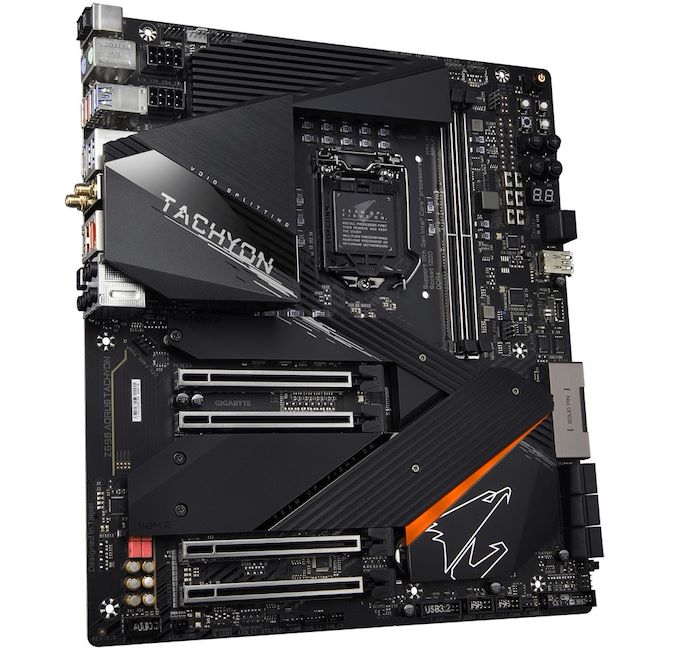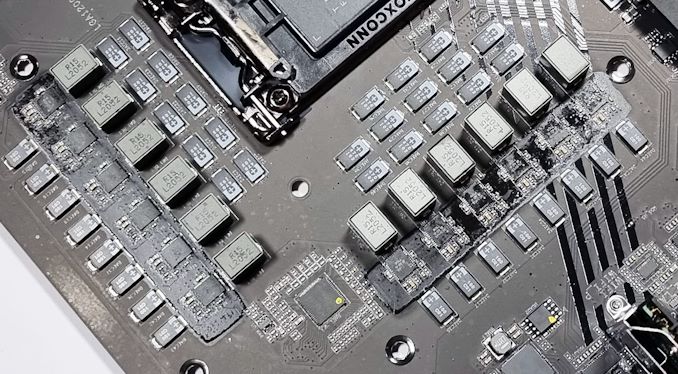GIGABYTE Z590 Aorus Tachyon Review: Built for SPEED
by Gavin Bonshor on May 10, 2021 9:30 AM ESTConclusion: This Board Clocks
Over the last month or so in our previous Z590 reviews, we've highlighted that to get the most out of Intel's unlocked Core K and KF 11th gen processors, the Z590 chipset is the go-to for performance users. Going beyond Intel's own integrated overclocking technologies, including both Thermal Velocity Boost (TVB) and Adaptive Boost Technology (ABT), requires adequate and quality hardware, but going beyond that with extreme cooling methods such as liquid nitrogen (LN2) requires the more premium products. While most users won't be looking at this space, it's where boards such as the GIGABYTE Z590 Aorus Tachyon enter the mix, with intricate and focused designs focused on benchmarking, both from a firmware and hardware point of view.
The GIGABYTE Z590 Aorus Tachyon is primarily designed for extreme overclockers looking to maximize both CPU and memory performance under sub-zero cooling methods. A lot of the design choices point directly to this. The two memory slots, which GIGABYTE has purposely located closer to the CPU socket, are designed to reduce latency penalties. The design includes shielded memory routing of the circuitry connecting the slots to the CPU socket. This is hidden under an inner layer of PCB which uses a larger ground layer that is designed to protect the signal from interference from external sources.
Another element that favors extreme overclockers is the CPU socket, with an array of Tantalum Polymer Capacitors, which inherently have a flatter design than other types of capacitors, making the mounting of pots used in sub-zero cooling methods easier to mount. Looking at the PCIe slot array, this also favors extreme overclockers looking to push limits on graphics cards, with two banks of full-length slots, the top two operating at PCIe 4.0 x16 and x8/x8, and the bottom two electronically locked down to PCIe 3.0 x4 and x1. The layout of these slots uses single slot spacing, which is consistent with an optimized design for extreme overclocking.
Focusing on the core features associated with the controllers used and chipset options, the Z590 Aorus Tachyon includes a solid networking array consisting of an Intel I225-V 2.5 GbE Intel AX210 Wi-Fi 6E CNVi. Other notable connectivity options include a single USB 3.2 G2x2 Type-C port on the rear panel and three USB 3.2 G2 Type-A and four USB 3.2 G1 Type-A ports. Users looking to add more Type-C connectivity can use the USB 3.2 G2 Type-C front panel header. For storage, the Tachyon has three M.2 slots, with one of these allowing for high-speed NVMe PCIe 4.0 x4 drives and the other two with both PCIe 3.0 x4 and SATA support. In terms of conventional storage, there's a total of eight SATA ports, with six controlled by the chipset with RAID 0, 1, 5, and 10 support, while the other two are operating from an ASMedia ASM1061 SATA controller.
In our performance testing, the Z590 Aorus Tachyon was competitive in our system tests, with some of the most efficient power consumption in all three tested states from all the boards we've tested so far. In our non-UEFI POST time test, the Tachyon was one of the quickest boards on test, with adequate performance in DPC latency. Our compute section of our test suite saw very competitive performance at default settings, with solid single-threaded performance results in Cinebench R23 and competitive multi-threaded performance.
Perhaps the bread and butter of the results came in our overclocking experience, with solid under-compensation of CPU VCore at full load, which as a direct result reduced overall CPU core temperatures and power consumption. The Tachyon also managed to run our Core i9-11900K at 5.3 GHz all-core stable, which is the first Z590 board we've tested so far to do this. Equipped with a direct 12-phase power delivery that operates with two PWM controllers, the CPU at 11+0 and SoC at 1+0, both elements are using Vishay SiC430 100 A power stages, which seems to point to a very efficient power delivery design. Our VRM thermal testing also confirms this with solid temperatures across the board, although we have to note that so far in our VRM thermal testing on Z590, many of the boards tend to dump a lot of the heat into the power plane of the power delivery.
Final Thoughts
The GIGABYTE Z590 Aorus Tachyon offers both elements for gamers and content creators, but it should be noted that to benefit most from the features and functionality, it would require sub-zero cooling. There's plenty for typical users including Intel 2.5 GbE, Wi-Fi 6E, and USB 3.2 G2x2 Type-C connectivity, but the overall design offers much more for extreme overclockers including the design layout, the premium power delivery, and as such, displayed some fantastic results in our overclocking testing. There's not much in the way of competition with the two main rivals, the ASRock Z590 OC Formula and ASUS ROG Maximus XIII Apex, both offering similar feature sets and containing a similar extreme pedigree. For enthusiasts and extreme overclockers, the Tachyon is a shining example of an extreme motherboard done correctly, but for the average joe, there's much more value in other Z590 options due to the large $530 price tag.
Overall, this board enables regular users to get the best out of their CPU, however paying the premium for that might not be a cost effective investment. Users who get the Tachyon will want the best of everything out of their processor. That's why extreme overclockers will fully enjoy the Tachyon.
We're set to use the Tachyon in an upcoming overclock comparison with some sub-zero cooling on a number of 11900K CPUs. Stay tuned for that review.












15 Comments
View All Comments
just_passin_by_2 - Tuesday, May 24, 2022 - link
Glass could also break or shatter dangerously*just_passin_by_2 - Tuesday, May 24, 2022 - link
so safety glasses could also be goodSlash3 - Monday, May 10, 2021 - link
You've got the PCI Express slot assignment listed incorrectly on the conclusion (possibly elsewhere).The slots are, from top to bottom:
Gen3 x4 (chipset)
Gen4 x16 (CPU)
Gen4 x8 (CPU, switched with second slot)
Gen3 x1 (chipset)
https://download.gigabyte.com/FileList/Manual/mb_m...
Amazing board, awful availability.
Silver5urfer - Monday, May 10, 2021 - link
Can I know what revision of the chip this board is using for the Intel 225V Foxville chip ? SLNMH or SLMNG ? If any of those then GB is using the B3 stepping, which is there on ASUS Maximus Z590 lineup as well. Revised one which doesn't have HW issues like prev ones.Also I hope you guys can get the Z590 DARK. The Z590 FTW is out already, why do you guys do not recommend any ASUS Maximus or Dark boards at all ?
jeremyshaw - Monday, May 10, 2021 - link
I would really hope Intel fixed the <10Mbps issue by the 3rd stepping.